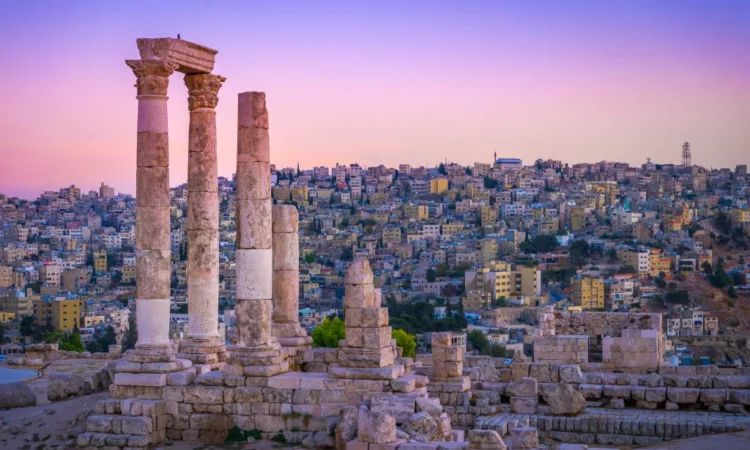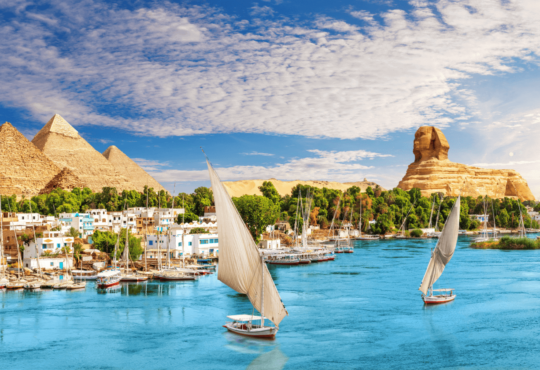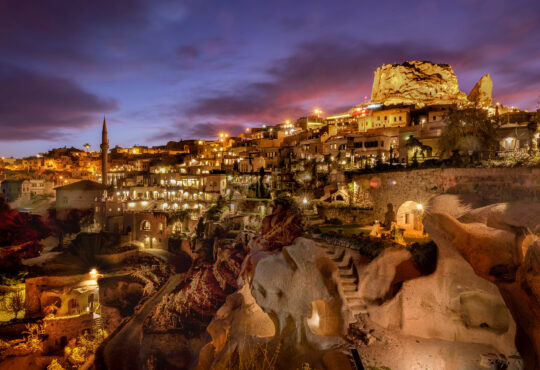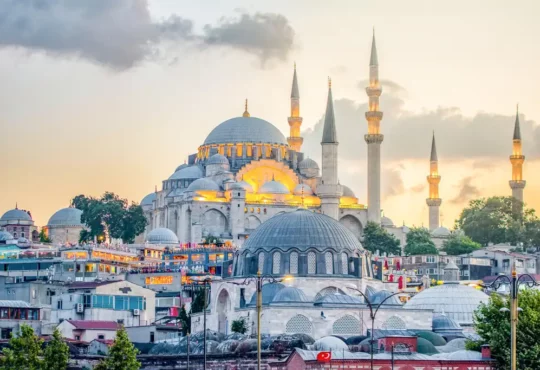
Amman serves as the capital city of the small-but-mighty Hashemite Kingdom of Jordan. A constitutional monarchy ruled by King Abdullah II since 1999, Jordan is filled to the brim with marvelous historical and cultural sights, delectable cuisine, and wonderful people.
The country has a storied history, with the first traces of human inhabitants stretching all the way back to Paleolithic times.
In classical antiquity, Jordan formed part of the Nabataean Kingdom, whose capital you can still see today at the jaw-dropping archaeological site of Petra. Later, Jordan was ruled by the Roman Empire, and lastly by the Ottoman Empire and a British protectorate, gaining independence in 1946.
Today, Jordan is a bustling commercial and economic hub in the region, and a definite bucket-list destination for many reasons.
Read on for the ultimate city guide to Amman, Jordan, with some bonus day trips at the end!
Wadi Rum, Jordan
VISA TO JORDAN | Yes, you need a visa to visit Jordan. It costs 40 JOD for most nationalities and can be obtained upon arrival. However, some nationalities must apply in advance of their trip.
LANGUAGE IN JORDAN | The official language of Jordan is Arabic, but English is widely spoken in most cities, with French and Italian spoke to a lesser extent.
MAIN AIRPORT | The Queen Alia International Airport is a beautiful and modern airport located in Amman, about half an hour from the city center.
CURRENCY USED IN JORDAN | Jordanian dinar JOD (1 JOD = 1,41 USD)
SAFETY IN JORDAN | Jordan is overall a very safe place to visit. Locals are friendly, helpful, and courteous, the local traditions are lovely, and it feels very safe to walk from one place to another. Violent crime is extremely rare in Jordan, but do be aware of pickpockets and scammers at popular tourist sites.
While tap water in Jordan is technically drinkable and has improved in recent years, many tourists and Jordanians alike still prefer bottled water, using tap water only for washing dishes.
The lack of municipal recycling makes drinking exclusively bottled water take a toll on the environment, but the water quality in Jordan varies a lot, making it a necessary evil sometimes. Toilet paper is not flushed but rather placed in a wastebasket next to the toilet to avoid pipe blockages.
If you’re visiting during Ramadan, be respectful about public food consumption during fasting hours. As always, if you see someone praying at any time of the day or year, be sure not to walk directly in front of them or interrupt them.
Many people in Jordan smoke cigarettes, and it is common to smoke both indoors and outdoors.
Tipping 10% in restaurants is common in Jordan. Tipping taxi drivers isn’t as common but is a nice thing to do if you had a good experience.
If you’re planning to visit the historical sites in Amman and the rest of the country, it is highly recommended that you purchase the Jordan Pass upon arrival.
The Jordan Pass is essentially a visa and tourism bundle, which includes a discount on the visa as well as entry to 40+ of the country’s best tourist attractions and museums, including Petra, Jerash, the Jordan Archaeological Museum, and more.
The Jordan Pass costs 70 JOD, which is almost always the best deal for tourists, given that the visa costs 40 JOD and a one-day visit to Petra alone costs 50 JOD.
If you want to visit all these attractions make sure you extend your trip to at least 10 days. Spending 10 days in Jordan will give you a chance to fully appreciate the country’s many highlights, as well as venture off the beaten path to discover some of its hidden gems.
DELVE INTO HISTORY AT THE JORDAN ARCHAEOLOGICAL MUSEUM, AMMAN CITADEL, ROMAN NYMPHAEUM, + ROMAN THEATER | All are included with your Jordan Pass, and it’s pretty easy to visit all of them in an afternoon. Start out by visiting the Archaeological Museum, which really sets the scene for what you’re going to see at the other sites. From there, it’s easy to walk over to the Roman Nymphaeum and Theater. The theater in particular is really impressive! Be sure to take a photo with the large Amman sign in front.
Next, you can either walk or take a taxi to the Citadel. The taxi ride should be very inexpensive, but it’s also walkable if you don’t mind lots of steps! The Citadel is absolutely awe-inspiring, with sweeping views of Amman and lots of great places for photos. Try to time your visit with the sunset.
VISIT SOME BEAUTIFUL RELIGIOUS PLACES AT THE KING ABDULLAH II MOSQUE, ABU DARWISH MOSQUE, + GRAND HUSSEINI MOSQUE | Keep in mind that you will need to have a head-covering to visit (females). Shorts, tank tops, and tight or revealing clothing are not allowed. You can go inside the Grand Husseini Mosque, which is conveniently located downtown, as well as the King Abdullah Mosque- Both are worth visiting!
ENJOY THE CAFE CULTURE AND STREET ART IN JABAL AMMAN, AND SHOP ‘TIL YOU DROP ON RAINBOW STREET | There are so many great bookstores, art galleries, and hipster cafes to check out in this area, as well as boutiques and beautiful architecture. It’s one of the most popular neighborhoods in Amman, for good reasons.
EXPLORE THE VARIOUS SOUKS AND SPICE MARKETS LOCATED AROUND DOWNTOWN | Be sure to sample some fresh-squeezed juice, too! One of the things that make Jordanian food so delicious is its use of spices like cardamom, mint, and za’atar.
FOR MORE WORLD-CLASS MUSEUMS FOR A VARIETY OF INTERESTS, CHECK OUT THE ROYAL AUTOMOBILE MUSEUM; THE JORDAN MUSEUM; OR THE JORDAN NATIONAL GALLERY OF FINE ARTS | All three are absolutely top-notch museums, and well worth a visit.
Sample delicious Syrian ice cream at Bakdash, and be sure to ask for pistachio topping!
Order hummus and falafel at Hashem, Jordan’s most famous falafel shop and legendary cheap eats locale. The falafel platter comes with pita, hummus, falafel, greens, and hot tea.
Enjoy delectable Yemeni food family-style at Bab al-Yemen. Their giant portions, comfortable seating and exceedingly kind serving staff make this a must-visit in Amman.
Try an Arabic-style coffee or choose from a delightful selection of teas at the cozy Rumi Cafe.
Sink your teeth into some warm Kunefa at Habibah Sweets, an Amman institution since 1951. Kunefa, a pastry made with shredded phyllo dough, syrup, cheese, and nuts, is best enjoyed hot and is an essential treat to try while you’re in Amman. It is also a famous dessert in Turkey.
- Nomads Hotel ($): Very close to downtown and really popular with visitors, there is a lovely rooftop terrace, free WiFi, and AC in the summer. This is a great place to meet other travelers, with a fun lounge area and outgoing staff.
- Jordan Tower Hotel ($): Lovely rooftop terrace area, within walking distance of the Roman Theater area.
- Caravan Hotel ($): Right next to the King Abdullah Mosque, includes breakfast and WiFi.
The best way to get around Amman is by driving or a taxi. Driving in Jordan can be tricky but taxis will do just fine, especially in the capital Amman.
Rates are reasonable and you can get from one part of the city to another fairly quickly. As in many cities, ensure that the driver turns on the meter when you enter. If they refuse, consider exiting and hailing another– refusing to turn on the meter is a common scam and a way to upcharge tourists. Ride-share companies such as Uber exist in Jordan but are not very common.
Many times the driver will request that you sit in the front seat of the car, as there have been confrontations with taxi drivers worried about Uber affecting their ridership. They will also sometimes request that you pay in cash rather than through the app. For that reason, Uber is perhaps an option for airport transfers but isn’t as common or useful in Amman as it is in other places around the world.
For airport transfers specifically, there are companies inside the terminals that are reputable to take you to your hotel or the center of the city.
Rush hour traffic in Jordan is absolutely legendary– and not in a good way. Many taxi drivers will be reluctant to take you back and forth around the city between 3 and 5 PM when traffic is at its worst. It’s best to wake up early for museums and explore Amman, in order to avoid traffic!
It merits mentioning that as you venture around Amman, attire is important. Jordanians are highly trendy and fashionable dressers, but as in much of the Middle East, the attire tends toward the conservative side.
If you wish to enter a mosque, you absolutely should keep in mind that women need a scarf or head-covering of some kind in order to enter, and shorts are not allowed. It’s a good idea to just keep a light scarf in your bag, so you’re able to cover your head if need be. It’s also best for either gender to wear loose-fitting clothes and avoid very revealing outfits, in order to be respectful of cultural norms.
A very popular souvenir from Jordan is a traditional scarf, called a keffiyeh. Traditionally, they come in a houndstooth pattern, with red worn by Jordanians and Bedouins and black worn by Palestinians. Some visitors opt to learn how to tie them around their heads the way Bedouins do. They’re also very trendy to wear as a normal scarf around your neck.
Absolutely worth bringing home is an assortment of Jordanian sweets, such as goats’ milk chocolate; baklava; or Basbousa, packed up in tins that are easy to transport. Arabic-style coffee and spices are also popular choices and packed in vacuum-sealed, travel-safe bags. Tangentially, if you’re a fan of British candy like Cadbury or chocolate-covered digestives that can’t be found anywhere in North America, Jordanian corner shops and grocery stores are filled with them!
Mud from the Dead Sea is also a popular souvenir to take home, which due to its mineral and healing properties makes it totally unique. There are also a variety of mask products made from mud.
Located about 250km south of Amman, Petra is a definite must-see, whether as a day trip or longer. First built sometime near the 1st century B.C.E. as the capital of the Nabataean Empire, Petra was a prominent trading hub for several centuries. It was abandoned somewhere around the 6th or 7th century for unknown reasons and later “rediscovered” in the 19th century, and is considered one of the most famous and best-preserved archaeological sites in the world.
The preservation of the rose-colored buildings, carved directly into the rock is just awe-inspiring, and there are ample opportunities for hiking and exploring. Petra is easily accessible by bus, which drops off right at the entrance. Admission is free with a Jordan Pass or 50 JOD if you don’t have one. Be sure to arrive early in the day to beat the tourist rush, and pack a lunch and plenty of water.
For a more relaxing and luxurious day, consider a visit to the intriguing Dead Sea, located about an hour’s drive from Amman. Considered the lowest-elevation place in the world at 423 meters below sea level, as well as one of the world’s saltiest, tourists flock to the Dead Sea to cover themselves in its mineral-rich mud and float on its super-salty surface.
There are a variety of hotels with Dead Sea day access passes in the area, and the Dead Sea can also be accessed from the Israeli side.
For another day trip focused on really neat archaeological and historical sites, check out nearby Ajloun Castle and the Gerasa archaeological ruins at Jerash, easy to do in a day on a combined bus tour. Ajloun Castle was built in the 12th century and boasted 7 limestone towers and a huge moat, imperative to protect the castle from Crusaders. The ruins at Gerasa (Jerash) date back to the Greco-Romans in the 2nd century and are unbelievably well-preserved, as well as less of a tourist trap than other ruins in Jordan, Europe, and other places.
Written by Tegan George & Alex McKenzie | Why Not Walk





